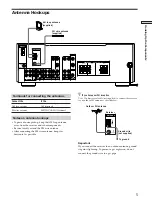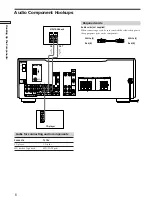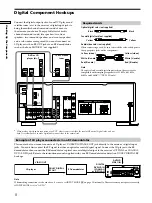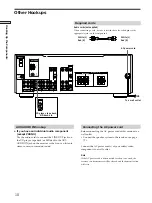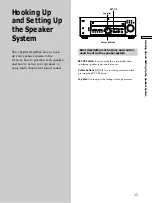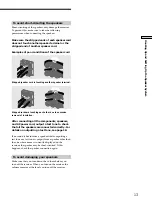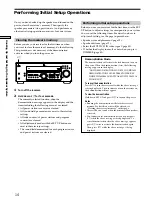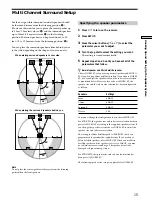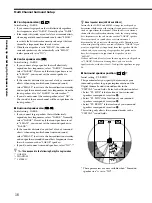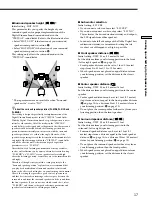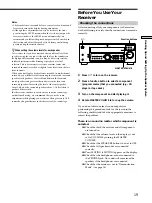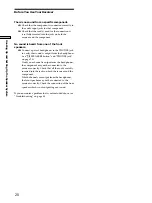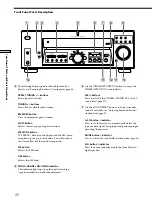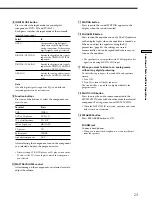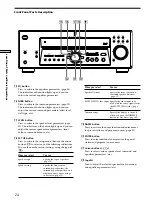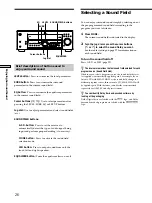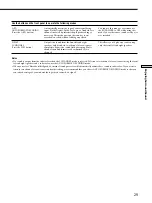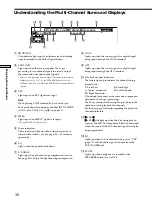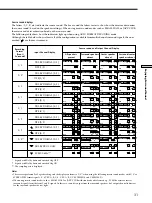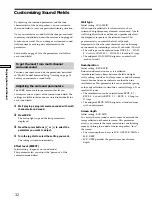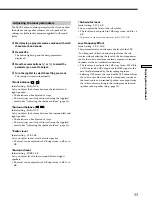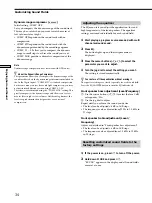
19
Hooking Up and Setting Up the Speaker System
Checking the connections
After connecting all of your components to the receiver,
do the following to verify that the connections were made
correctly.
1
Press
?
/
1
to turn on the receiver.
2
Press a function button to select a component
(program source) that you connected (e.g., CD
player or tape deck).
3
Turn on the component and start playing it.
4
Rotate MASTER VOLUME to turn up the volume.
If you do not obtain normal sound output after
performing this procedure, look for the reason in the
following checklist and take the appropriate measures to
correct the problem.
There is no sound no matter which component is
selected.
,
Check that both the receiver and all components
are turned on.
,
Check that the volume level on the display is not
set to VOL MIN by turning the MASTER
VOLUME.
,
Check that the SPEAKERS button is not set to OFF.
,
Check that all speaker cords are connected
correctly.
,
Press MUTING if MUTING appears on the display.
,
Check that the headphones are not connected to
the PHONES jack. No sound will come from the
speakers if the headphones are connected.
,
Check that the receiver is not in “Demonstration
Mode” (see page 14).
Before You Use Your
Receiver
Notes
• The front balance, surround balance, center level, and surround
level are shown in the display during adjustment.
• Although these adjustments can also be made via the front
panel using the LEVEL menu (when the test tone is output, the
receiver switches to the LEVEL menu automatically), we
recommend you follow the procedure previously described in
this section and adjust the speaker levels from your listening
position using the remote control.
z
When setting the volume levels for each speaker
Let’s assume that you have matched the sound levels of all the
speakers using the test tone. Although this lays the foundation
for high quality surround sound, it may be necessary to make
further adjustments while listening to playback of actual
software. This is because most software contains center and
surround channels recorded at slightly lower levels than the two
front channels.
When you actually play back software recorded in multi channel
surround, you will notice that increasing the center and surround
speaker levels produces a better blend between the front and
center speakers and greater cohesion between the front and
surround speakers. Increasing the level of the center speaker
about 1 dB, and the surround speakers about 1~2 dB is likely to
produce better results.
In other words, in order to create a more cohesive soundstage
with balanced dialog, we recommend that you make some
adjustments while playing your software. Changes of only 1 dB
can make a huge difference in the character of the soundstage.
MULTI CHANNEL DECODING
INPUT MODE
MUTING
VIDEO
MD/TAPE
DVD/LD
CD
TV/SAT
TUNER
AUX
DISPLAY
DIMMER
PHONES
SPEAKERS
?
/
1
MEMORY
SHIFT
FM MODE
FM
AM
EQ
SURR
LEVEL
SET UP
NAME
A
ENTER
A.F.D.
SOUND FIELD
MULTI CH IN
EQUALIZER
CINEMA STUDIO EX
MODE
2CH
PRESET
TUNING
TUNING
–
+
–
+
B
C
MASTER VOLUME
–
+
MASTER VOLUME
1/u
Function buttons

